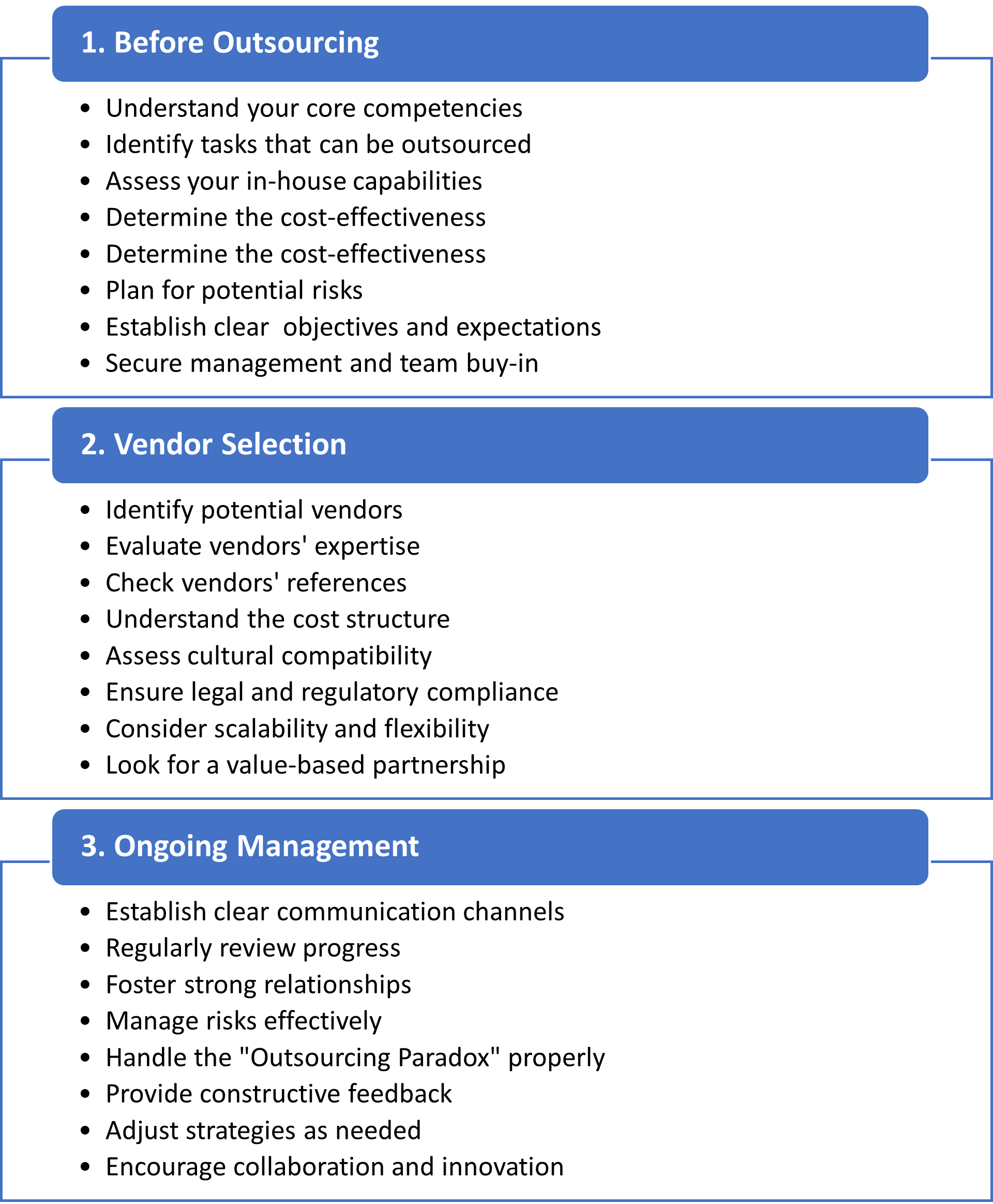Navigating the IT outsourcing landscape: A value-driven approach.

Backstory
Recently, I shared a post on LinkedIn discussing the challenges and negative perceptions often associated with IT outsourcing. My intention was to highlight one of the common issues troubling the outsourcing industry – the pitfalls associated with low-cost outsourcing, and to propose the idea of a shift towards a more value-driven approach.
Thomas Spitzer, a professional with decades of experience in software development and outsourcing, responded with an insightful article that approached the topic from a different perspective. I appreciate Thomas’s thorough analysis and his willingness to engage in this important dialogue. This rich exchange underscores the complexity of outsourcing and set the stage for a more in-depth exploration of the topic.
It’s clear that the process of outsourcing is multifaceted, often leading to varying outcomes for different stakeholders. Therefore, it’s crucial to examine these issues from multiple angles. This article aims to do just that, delving into the challenges of outsourcing, sharing experiences from my company, TechCells, and proposing a better approach for successful IT outsourcing.
This is not just a response to Thomas, but also an exploration and further discussion on the broader subject of IT outsourcing. While he and I might not “see eye to eye” on every aspect (also agreeing on some), I believe we share a common goal: to improve the quality and success rate of IT outsourcing engagements. This post is a step towards just that.
The Perception and Reality of IT Outsourcing
The reputation of IT outsourcing, particularly in the context of offshoring, has its ups and downs, often veering towards the negative. This perception is not without cause. According to a 2020 Global Outsourcing Survey by Deloitte, approximately 25% of outsourcing relationships fail within two years, and this number jumps to nearly 50% within five years.
While it’s important to note that not all issues of outsourcing are bound to cost-related factors, as I suggested in my original LinkedIn post, it’s undeniable that a significant amount of issues revolve around this aspect. Outsourcing is a multifaceted process and can be influenced by a myriad of factors, including communication barriers, cultural differences, and misaligned expectations, which I will delve deeper into in the following sections.
Cost, however, remains a strong motivating factor when it comes to outsourcing decisions. Deloitte’s survey also revealed that 59% of businesses surveyed cited cost-cutting as a key reason to outsource. This trend towards low-cost solutions can sometimes lead to pitfalls that sour the outsourcing experience and contribute to its negative reputation.
At TechCells, we have witnessed firsthand the results of this cost-centric approach. One particular example involves a New York based healthtech client who initially chose a low-cost outsourcing vendor to develop a critical application. They soon found themselves dealing with subpar quality of work, missed deadlines, and a general lack of transparency from the vendor. Frustrated and in need of a solution, they turned to us. Despite the higher costs than their original vendor, they recognized the value we offered in terms of skill, transparency, and reliability. Their story ended on a positive note, but many businesses aren’t as fortunate and end up bearing the brunt of a poor outsourcing experience.
These real-life experiences combined with the revealing statistics from studies like Deloitte’s, underscore the need for a shift in the way we approach outsourcing. It’s time we move beyond a narrow focus on cost-cutting like it is in most deals and embrace a value-driven model, which prioritizes quality, effective communication, and strategic partnership. In fact, this can cost less in the long run! Doing so helps to change the narrative around IT outsourcing somehow and make it a tool for growth and innovation rather than a source of concern.
The Three Sides of Successful Outsourcing
When it comes to successful IT outsourcing, I believe there are three key stages that need careful attention and thoughtful consideration:
- Pre-outsourcing stage
- Vendor selection process
- Ongoing management of the outsourcing relationship
Each stage has its own set of challenges and requirements that, if overlooked, can lead to the failure of the outsourcing engagement. Let’s take a closer look at each stage.
Pre-Outsourcing: Are You Ready?
The decision to outsource should never be taken lightly. Before embarking on this journey, organizations need to thoroughly assess their readiness for outsourcing. This involves evaluating the company’s internal capabilities, identifying the tasks that can be outsourced, and defining clear objectives for the outsourcing engagement. The organization also needs to consider its readiness to manage the change that outsourcing will bring about, including potential impacts on internal staff and workflows.
In my experience, a common mistake organizations make at this stage is not having a clear understanding of their own requirements. This can lead to mismatched expectations and conflicts later on. It’s essential to clearly define the scope of work, the expected outcomes, and the criteria for success before starting the outsourcing process.
Vendor Selection: Can You Choose the Right Partner?
The next crucial stage is the selection of the outsourcing vendor. This decision can make or break the outsourcing engagement. While cost considerations remain on the table, organizations should not just focus on it, but also consider the vendor’s expertise, track record, and compatibility with the organization’s culture and values. Look for vendors who can demonstrate a commitment to quality, effective communication, and long-term partnership.
Ongoing Management: Can You Do Your Part?
The final stage is the ongoing management of the outsourcing relationship. Even after the vendor has been selected and the work has begun, the organization’s role is not over. In fact, this is where the real work begins. Successful outsourcing requires active involvement and effective management from the client’s side.
A common mistake at this stage is the failure to maintain open and regular communication with the vendor. This can lead to misunderstandings, delays, and dissatisfaction on both sides. It’s crucial to establish clear communication channels, provide timely feedback, and address any issues promptly.
Another frequent pitfall is what I call the “outsourcing paradox”. This is when a company, lacking expertise in a certain area, outsources the task to a more expert vendor but then attempts to tell them how to do the job. This approach undermines the very rationale for outsourcing and negates the benefits that come from leveraging the vendor’s expertise. Instead, organizations should focus on defining the desired outcomes and leave the how-to to the experts they’ve hired.

Outsourcing stages and important considerations
Cost vs Value: Advocating for a Paradigm Shift
In my original LinkedIn post, I advocated for a shift from a cost-focused to a value-driven approach to IT outsourcing. I believe this is key to overcoming many of the challenges and negative perceptions associated with outsourcing.
A cost-focused approach often leads to a short-term mindset and transactional relationships. It tends to prioritize immediate cost savings over long-term value creation, and can lead to a ‘race to the bottom’ in terms of quality and service. This approach is likely to result in many of the problems I outlined in my original post, from poor quality work and missed deadlines to ineffective communication and a lack of long-term commitment.
On the other hand, a value-driven approach to outsourcing prioritizes the creation of long-term value over immediate cost savings. It encourages a strategic, partnership-based approach to outsourcing, where both parties are invested in each other’s success. This approach promotes a focus on quality, service, and mutual benefit, rather than just cost.
Consider an example from TechCells. We partnered with a California-based client, entering into a long-term relationship that went beyond just delivering high-quality software development work. Our connection with this client evolved into a genuine partnership where we are both deeply invested in each other’s success.
We frequently organize discussions between the sales and marketing departments of our two companies, fostering knowledge sharing and a better understanding of each other’s markets and strategies. This collaboration has proven to be mutually beneficial, offering valuable insights that help us refine our services and assist them in enhancing their operations.
Moreover, our relationship extends beyond our core offerings. We leverage our extensive network to assist them in various other business aspects, such as connecting them with trusted partners that can further their business objectives. These value-added gestures have become an integral part of our relationship, reinforcing our commitment to their success and furthering their trust in us.
In this partnership, the client does not just get a service provider; they get a strategic partner. They have expressed immense satisfaction with our services and appreciate the additional value we bring. The focus here is not solely on how much our services cost but the overall value they derive from our partnership.
This is precisely what I advocate when I speak of prioritizing value-based relationships in IT outsourcing. It’s about seeing beyond the immediate cost and understanding the long-term value that a well-aligned outsourcing partnership can deliver. It’s about creating an environment where both parties are not just involved but committed to each other’s success. It’s about being not just penny wise, but pound wise.
Conclusion: Revisit the Dialogue
Reflecting on the dialogue that initiated this discussion, it’s clear that Thomas and I share common ground on several aspects of IT outsourcing. We both acknowledge the complexity of outsourcing, the myriad factors contributing to its success or failure, and the vast potential it holds when executed correctly.
However, where our perspectives diverge is around the centrality of cost in the outsourcing equation. While it’s true that not all issues of outsourcing are bound to cost-related factors, my experiences, both personally and through TechCells, suggest that a significant proportion of outsourcing failures can be traced back to a primary focus on cost minimization. It is this cost-centric approach that often leads to the negative outcomes I outlined in my original post – poor quality, poor support, missed deadlines, and fractured relationships.
To address this, I advocate for a paradigm shift – a move from a cost-centric approach to a value-centric approach. This is not to say that cost becomes irrelevant, but rather, it’s about understanding the larger value proposition that a strategic outsourcing partnership can offer. It’s about recognizing that the cheapest option may not always be the best option.
Take the example of our California-based client at TechCells, who is enjoying outsourcing their IT needs to central Aisa. Our long-term partnership with them is not just about delivering software development services, but about adding value in several other ways – through shared knowledge, through our network connections, and through our joint commitment to each other’s success. Our partnership is not just about cost savings, but about creating mutual value.
In conclusion, while outsourcing is a complex strategy with many factors influencing its success, one of the key issues underpinning its failures is the overemphasis on low cost. By shifting the focus from cost to value, we can transform outsourcing from a cost-saving tactic into a strategic, value-adding partnership. This shift requires a different mindset, one that views outsourcing not just as a transactional relationship, but as a long-term, mutually beneficial partnership.
Rather than asking, ‘How much is your rate?’, we should be asking, ‘What is the price of you providing the best service for me and what value am I receiving for the investment I’m making?’ This subtle shift in our line of questioning underscores the shift from cost-centrism to value-centrism and will significantly influence the success of our outsourcing endeavors.
It’s time to be not just penny wise, but pound wise.
Are you looking to hire a tech team?
Talk to a TechCells representative now
-
United States
332 South Michigan Ave, Suite 121 #5998, Chicago, IL 60604, United States
+1 (312) 779-1115
